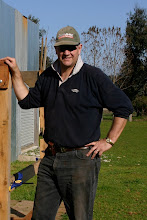S
Well - I've finished my first Spring and Summer of cell grazing. Seasonal condisitions have been so good and unusual that my cattle couldn't eat their way around the farm even once.
Since mid September I have grazed around 62% (11.9 ha) of the farm once - usually giving the cattle only one or two day's feed at a time. I cut hay from 16% (3.1 ha) - which I wouldn't normally do. I then also have 4 paddocks which I'm going to get mulch mown and just leave this year's grass to compost on the ground. That's 22% (4.3 ha) of the farm.
Initially I was just feeding 22 animals, then it dropped to 13 when the 2009 calves went to Millet Rd ... before the cows and calves came back to see the new bull and I had 48 animals here for a couple of months! The cows and calves went back to Benson Rd and Boundary Rd and the Millet Rd stock came back home - and I presently have 25.
My best cows are at the agistment properties. They are 'best' in the sense that they produce calves without drama. At Moora Farm I have 4 cows that are 'on probation' for various reasons plus my Dun cow (because she's cute) plus just one maiden heifer this year. I then also have the bull - and 18 steers. That makes a total herd of 25 at Moora Farm and 55 in all ... before someone goes to slaughter later this week.
If it sounds like I've been moving cattle around a bit ... I have, but it hasn't been so bad. I need better loading facilities in a couple of places, but I have a good trailer and the cattle are fairly cooperative. It is well worthwhile to get inexpensive access to more land. It works for my agistment farmers as well - as they get to look after my beautiful animals and bring land into production that would otherwise be idle.
The grazing regime at Moora is has produced a very significant increase in the quality of each paddock that has been cell grazed. The pasture sward is thicker and more species are volunteering into the mix along with the primary ryegrass and clover. I have several paddocks with Phalaris - and those are the ones where the growth is most spectacular. What I don't really know is how good is the Phalaris vs other grasses.
The cattle are now back in paddock 12 - which is one of the those Phalaris paddocks. The cattle grazed 12 from mid September through to 24 October. I could easily have grazed it again by the start of January - at the latest. You can see in this photo the mature Phalaris is almost 6 ft high. There is plenty of clover, ryegrass and other bits and pieces at the base.
It is interesting to watch the cattle when they get access to a new area. Most of them start by nibbling at the heads of the tallest grasses. The next priority seems to be anything more unusual - which might be weeds or some sappy annual ryegrass against the fence. Then the settle down to 'eat their greens' - ie the rest of the pasture.
Under the (remote) tutelage of Peter Andrews I am learning to relax about things I have previously thought of as weeds. Andrews, and Pat Coleby for that matter, believe animals eat what they need. The way they go for the stuff we are told to eliminate - you have to wonder.
A couple of weeks ago there was a patch of Marshmallow in a particular part of the paddock. Perhaps I should have checked before they got access, but in they went. First thing they ate! Checking online just now, I see that it's supposed to cause nitrate staggers. If it did, I didn't notice - and I did almost lose a couple of cattle from this cause eating too of a forage brassica called Winifred a few years ago.
I'd be interested in other people's experience with cattle eating weeds.
F
Sunday, April 24, 2011
Subscribe to:
Post Comments (Atom)





No comments:
Post a Comment